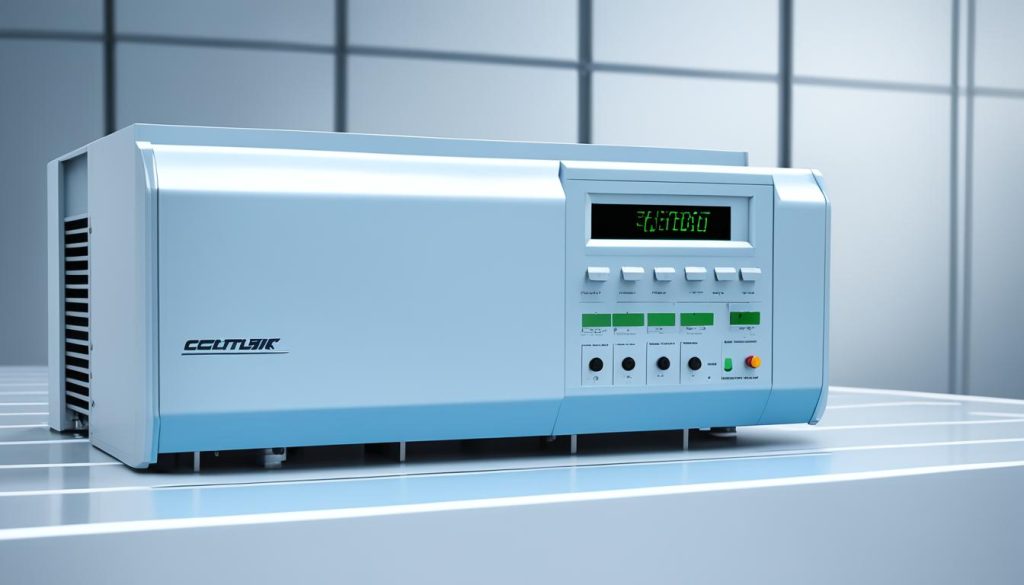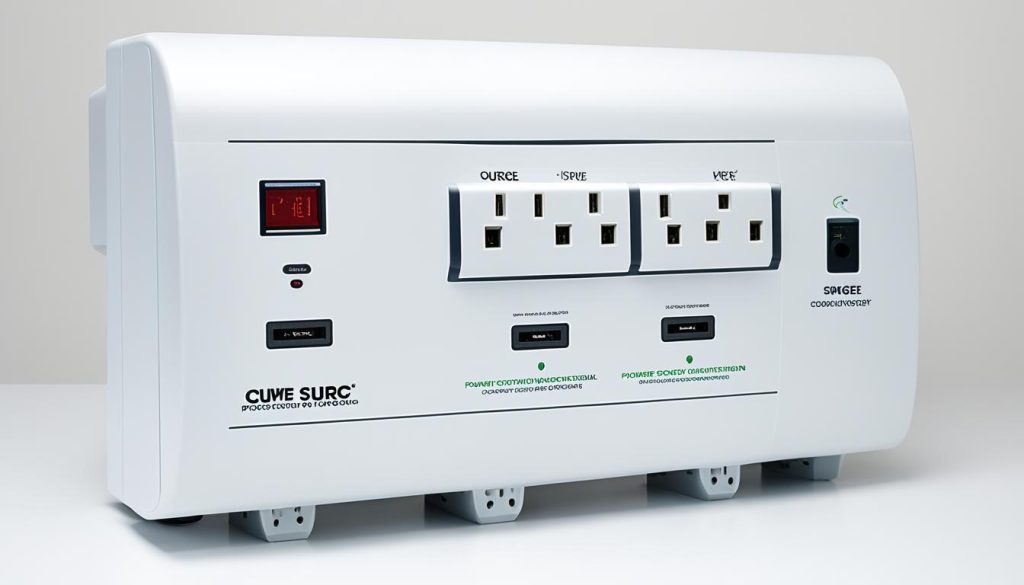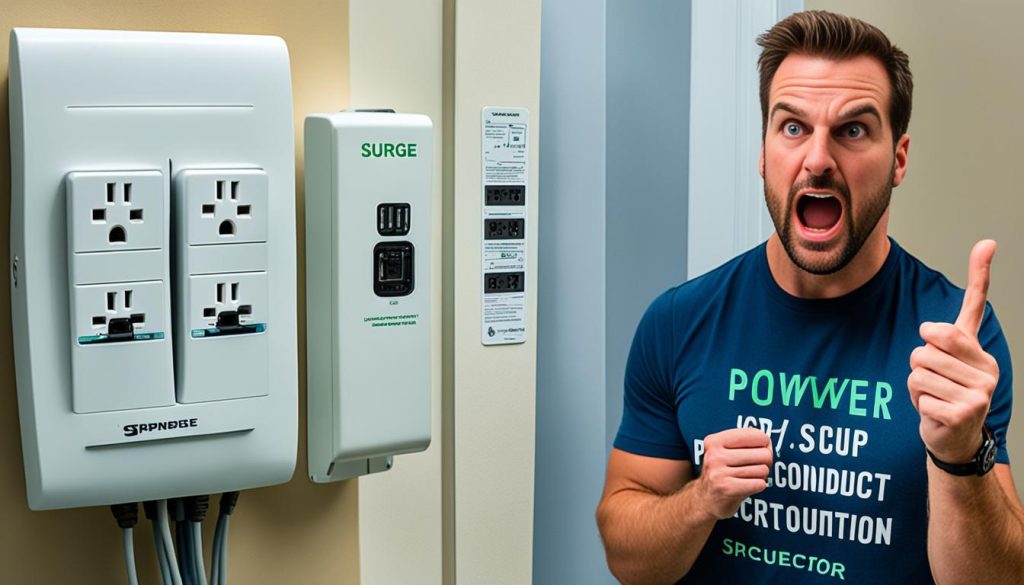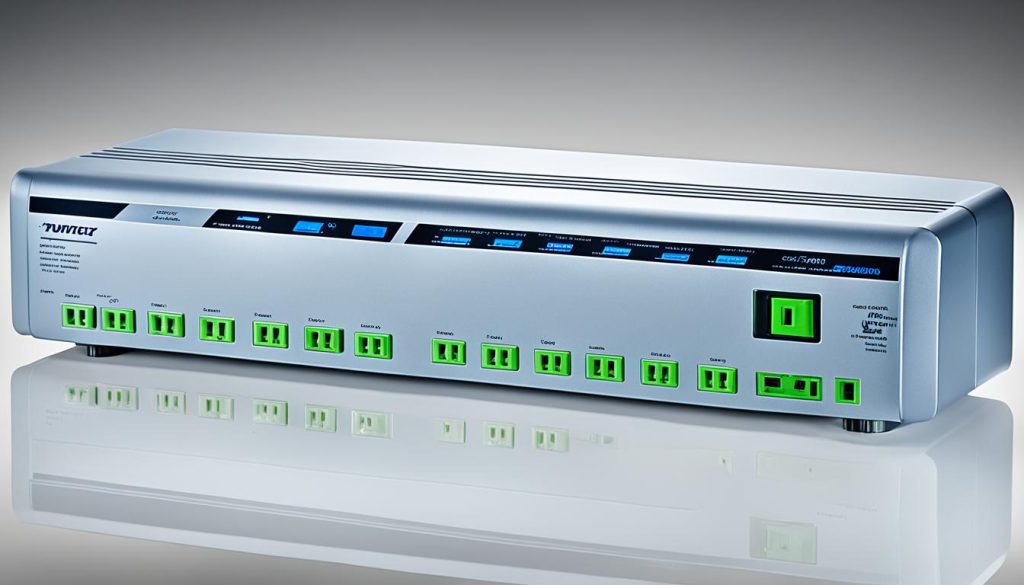When it comes to protecting your valuable electronics, understanding the difference between a power conditioner and a surge protector is crucial. Both devices play a vital role in safeguarding your devices from voltage fluctuations and power surges, but they offer different levels of protection and functionality. Let’s explore the key differences between these two power protection devices to help you make an informed decision for your needs.
A power conditioner utilizes advanced power conditioning technology to regulate and clean the incoming power, ensuring that your electronic devices receive a stable and consistent voltage level. By eliminating powerline noise and improving power quality, power conditioners provide comprehensive protection for your sensitive equipment. They are particularly beneficial for devices with higher power demands, such as audio/video systems, copiers, and laser printers.
On the other hand, a surge protector offers basic protection against power surges by diverting excess voltage away from your devices. Surge protectors use various electronic components, such as silicon avalanche diodes (SADs), metal oxide varistors (MOVs), and gas tubes to absorb and redirect the excess energy. While surge protectors are effective at limiting the damage caused by voltage spikes, they do not provide the same level of power conditioning as power conditioners.
To summarize, power conditioners provide comprehensive power protection by regulating voltage, cleaning the power, and eliminating powerline noise. Surge protectors, on the other hand, offer basic protection by diverting excess voltage. Choosing the right power protection device depends on your specific needs, the sensitivity of your equipment, and the quality of your facility’s electricity. Understanding the differences between power conditioners and surge protectors can help you make an informed decision for optimal power quality management and surge protection for your electronics.
Key Takeaways:
- Power conditioners provide comprehensive power protection by regulating voltage, cleaning power, and eliminating powerline noise.
- Surge protectors offer basic protection by diverting excess voltage away from your devices.
- Power conditioners are beneficial for devices with higher power demands and require stable and regulated power.
- Surge protectors are cost-effective options for basic surge protection.
- Assess your specific needs, equipment sensitivity, and facility’s electricity quality when choosing between power conditioners and surge protectors.
The Role of Surge Protectors
Surge protectors, also known as surge diverters, play a critical role in safeguarding electronic systems against voltage spikes or transients. These devices are designed to protect delicate electronic components by diverting the harmful energy away from the devices, ensuring their longevity and reliable performance.
Surge protectors rely on various electronic components, such as silicon avalanche diodes (SADs), metal oxide varistors (MOVs), and gas tubes, to effectively redirect excessive voltage surges. Each of these components has its own set of advantages and disadvantages, making them suitable for different applications.
MOVs, for example, are commonly used in surge protectors due to their ability to handle high-energy surges. However, they have a relatively high clamping voltage and slower response time. On the other hand, SADs offer faster response times but can handle lower amounts of energy. Gas tubes, while slower, are capable of handling unlimited amounts of energy.
Surge protectors are designed with a clamping voltage threshold, which is the voltage level at which they start conducting, and a clamping response time, which is the time they require to react to a surge. These factors determine how effectively surge protectors can protect electronic devices against voltage spikes.
Surge protectors are effective in limiting the worst part of a catastrophic electrical impulse, but it’s important to note that they have certain fundamental limitations. Additionally, their performance can vary depending on the specific characteristics of the wiring system.
Advantages and Disadvantages of Surge Protectors
| Advantages | Disadvantages |
|---|---|
| 1. Affordable and widely available | 1. Limited protection against power fluctuations |
| 2. Easy to install and use | 2. Performance varies based on the wiring system |
| 3. Can handle high-energy surges | 3. Clamping voltage may be higher, leading to potential damage |
| 4. Acts as the first line of defense for electronic devices | 4. Slower response time compared to other protection devices |
Despite their limitations, surge protectors remain an essential component of any comprehensive power protection strategy. Their affordability, ease of use, and ability to handle high-energy surges make them an attractive option for protecting electronic devices against voltage spikes and ensuring their longevity.
Understanding Power Conditioners
Power conditioners, also known as line conditioners, are electrical devices that enhance the quality of the power supplied to your electronic equipment. They play a crucial role in ensuring that your sensitive devices receive the correct voltage level and are protected from power fluctuations and interference.
Power conditioners utilize various technologies such as voltage regulation, isolation transformers, and powerline noise filters to provide comprehensive protection for your electronic equipment.
Voltage regulation is one of the key features of power conditioners. It ensures a stable and consistent supply of voltage, preventing issues caused by overvoltage or undervoltage. By regulating the voltage, power conditioners eliminate the risk of damage to your devices due to high or low voltage situations.
Isolation transformers are another important component of power conditioners. They are designed to eliminate common mode voltages that can cause disruptions in the operation of computer systems. By isolating the equipment from the main power supply, these transformers minimize the risk of electrical noise and interference.
Furthermore, power conditioners incorporate powerline noise filters to improve audio and video quality. These filters reduce line noise, such as electromagnetic interference (EMI) and radio frequency interference (RFI), resulting in a cleaner and more stable power supply for your electronic devices.
Power conditioners are particularly beneficial for modern systems powered by switch mode power supplies (SMPS) that are sensitive to powerline noise, impulses, and common mode voltage. By employing the right power conditioner, you can ensure optimal performance and longevity for your equipment.

Understanding how power conditioners work and the benefits they provide is crucial in maintaining the power quality necessary for your electronic equipment to function at its best.
Surge Protectors vs Power Conditioners: The Main Differences
When it comes to protecting your electronic devices, understanding the differences between surge protectors and power conditioners is crucial. While both devices offer some level of protection, they serve different purposes and provide varying levels of defense against power-related issues.
Surge protectors primarily safeguard your electronics against surges and spikes in voltage. They act as a barrier, diverting excess voltage away from your devices and preventing damage.
On the other hand, power conditioners go beyond surge protection and offer additional benefits for your electronics. They not only protect against surges but also provide protection against brownouts, regulate voltage, and eliminate powerline noise.
Brownouts are voltage drops that can occur when the power supply to your devices temporarily decreases. These fluctuations can cause malfunctions or damage to sensitive electronic equipment. Power conditioners counteract brownouts by regulating the incoming voltage, ensuring your devices receive a stable power supply.
Power conditioners are designed to improve the quality of the power supplied to your electronic equipment. They act as a line of defense against a wide range of power-related issues, including surges, spikes, brownouts, and powerline noise. By providing stable and clean power, they enhance the performance and longevity of your electronics.
In addition to voltage regulation, power conditioners also offer EMI/RFI filtering. EMI (Electromagnetic Interference) and RFI (Radio Frequency Interference) are commonly found in power lines and can affect the performance of your electronics. Power conditioners eliminate these interferences, ensuring a clean power supply for your devices.
Furthermore, power conditioners can provide battery backup power, allowing your electronics to continue functioning during a power outage. This feature is especially valuable for critical systems or equipment that cannot afford downtime.

In summary, the main differences between surge protectors and power conditioners can be summarized in the table below:
| Surge Protectors | Power Conditioners |
|---|---|
| Protection against surges and spikes | Protection against surges, spikes, and brownouts |
| Basic voltage diversion | Voltage regulation |
| No power conditioning | EMI/RFI filtering |
| No battery backup power | Battery backup power (certain models) |
Ultimately, the choice between a surge protector and a power conditioner depends on your specific needs and the level of protection required for your electronics. If you have devices that require stable and regulated power supply, such as copiers or laser printers, a power conditioner may be the ideal solution. However, if you primarily need protection against surges and spikes at a lower cost, a surge protector can provide basic defense. For uninterrupted power supply during outages, a UPS system that combines surge protection with battery backup power may be the best option.
Choosing the Right Power Protection Device
When it comes to safeguarding your valuable electronic equipment, selecting the right power protection device is essential. In order to make an informed decision, consider various factors such as your specific equipment needs, the power quality of your facility’s electricity, the operating environment, and budget considerations. By carefully assessing these aspects, you can determine whether a power conditioner or a surge protector is the ideal choice for your requirements.
If you have sensitive electronic equipment that requires stable and regulated power, a power conditioner may be the best option for you. Power conditioners, also known as line conditioners, offer comprehensive protection by regulating and cleaning the incoming power. They ensure a stable voltage supply, eliminate powerline noise, and protect your devices from voltage fluctuations and interference. Power conditioners are particularly beneficial for modern systems powered by switch mode power supplies (SMPS) that are sensitive to powerline noise and disturbances.
On the other hand, if your primary concern is protection against surges and spikes, a surge protector can offer basic protection for your electronics. Surge protectors divert excessive voltage away from your devices, preventing damage caused by power surges. They are an affordable option and suitable for general surge protection needs.
It’s important to consider your budget when selecting a power protection device. Power conditioners generally have a higher upfront cost but may require less frequent replacement compared to surge protectors, making them a more cost-effective long-term solution. However, if budget is a constraint, a surge protector can provide basic surge protection at a lower cost.
Consulting with a professional can also help you make an informed decision based on your specific requirements. They can assess your equipment needs, evaluate the power quality of your facility, and consider the operating environment to recommend the most suitable power protection device.
Key Considerations for Choosing the Right Power Protection Device:
- Specific equipment needs for stable and regulated power
- Power quality of your facility’s electricity
- Operating environment
- Budget considerations

In this section, we discuss the importance of choosing the right power protection device for your equipment needs. Whether you require stable and regulated power or basic surge protection, assessing your specific requirements and considering factors such as power quality, environment, and budget considerations can help you make an informed decision. Consulting with a professional can further ensure that you select the most suitable power protection device for optimal performance and longevity of your electronics.
Importance of Power Surge Protection
Power surge protection plays a crucial role in safeguarding your valuable electronics from various risks and potential damages. Lightning strikes, voltage drops, and power failures are common occurrences that can pose significant threats to your electronic devices. By investing in power surge protection devices, such as surge protectors, power conditioners, or UPS systems, you can effectively mitigate these risks and ensure the uninterrupted operation of your electronic equipment.
Lightning strikes are one of the most common causes of power surges. When a lightning strike occurs near a power line, it can generate a massive electrical surge that travels through the wiring and can easily damage sensitive electronic components. This can lead to costly repairs or even render the devices irreparable.
Voltage drops are another common concern that can affect the performance of your electronics. These drops occur when the voltage supplied to your devices falls below the required level, causing them to malfunction or completely shut down. Voltage drops can be caused by various factors, including fluctuations in the power grid or the operation of high-power electrical equipment in the vicinity.
Power failures, whether due to natural disasters, equipment failures, or other unforeseen circumstances, can have detrimental effects on your electronics. These interruptions can result in downtime, lost productivity, and financial losses for businesses. Considering that the Electric Power Research Institute estimates the national cost of power interruptions to be approximately $80 billion, it is evident that the impact on the economy can be substantial.
By implementing power surge protection measures, you can mitigate the risks associated with lightning strikes, voltage drops, and power failures. Surge protectors, power conditioners, and UPS systems provide different levels of protection, depending on your specific needs. Surge protectors, for example, divert excess voltage away from your devices, ensuring they receive only the required amount of power. Power conditioners go beyond surge protection by regulating and cleaning the incoming power, eliminating issues like powerline noise and voltage fluctuations.
The following table provides a comparison of the risks and the impact on electronics and the economy:
| Risks to Electronics | Impact on the Economy | |
|---|---|---|
| Lightning Strikes | Potential damage to electronic components | Possible costly repairs or replacements |
| Voltage Drops | Device malfunction or shutdown | Disruption of operations, reduced productivity |
| Power Failures | Downtime, potential data loss | Lost revenue, decreased customer satisfaction |
| Cost of Power Interruptions | N/A | Approximately $80 billion nationally |

Safeguarding your electronics with power surge protection is not only essential for protecting your devices but also for preventing potential financial losses and maintaining the smooth operation of your equipment. By investing in the right surge protection devices, you can significantly reduce the risk of damages caused by lightning strikes, voltage drops, and power failures, ensuring the longevity and reliability of your electronic devices.
Conclusion
When it comes to protecting your electronic equipment from power surges, choosing the right device is crucial. Power conditioners and surge protectors offer different levels of protection, each catering to specific needs. Power conditioners provide comprehensive power protection by regulating voltage and filtering out powerline noise, ensuring a stable power supply for sensitive electronics. On the other hand, surge protectors offer basic protection by diverting excess voltage away from your devices.
When making a decision, assess your equipment needs, the quality of your facility’s electricity, and your budget considerations. If your equipment requires stable and regulated power, a power conditioner is the ideal choice. However, if you primarily need protection against surges and spikes, a surge protector can provide basic safeguarding at a lower cost. Keep in mind that investing in power surge protection is essential for preventing damage to your electronics and maintaining their functionality and longevity.
Remember, power quality management is crucial in maintaining the optimal operation of your electronic devices. By choosing the right power protection device, you can ensure that your valuable equipment remains protected from power fluctuations, reducing the risk of downtime and costly repairs or replacements. Take the time to evaluate your specific needs and make an informed decision to safeguard your electronics effectively.
FAQ
What is the difference between a power conditioner and a surge protector?
A power conditioner regulates and cleans the incoming power, providing full protection by ensuring stable voltage supply, eliminating powerline noise, and protecting against brownouts. A surge protector, on the other hand, offers basic protection by diverting extra voltage away from your devices during power surges and spikes.
How do surge protectors work?
Surge protectors use electronic components such as silicon avalanche diodes (SADs), metal oxide varistors (MOVs), and gas tubes to divert excess voltage away from electronic devices. These components have clamping voltage thresholds, response times, and maximum energy handling capabilities to limit the impact of voltage spikes.
What are the benefits of power conditioners?
Power conditioners provide comprehensive power protection by regulating voltage, cleaning the power supply, and eliminating powerline noise. They ensure stable power supply, protect against surges, protect against brownouts, and improve audio/video quality.
What are the advantages of surge protectors?
Surge protectors offer basic protection against power surges and spikes, diverting excess voltage away from electronic devices. They are cost-effective and can safeguard devices from potential damage during voltage fluctuations.
How are power conditioners and surge protectors different?
Power conditioners provide full protection by regulating voltage, cleaning power supply, and eliminating powerline noise. Surge protectors, on the other hand, offer basic protection by diverting excess voltage only during power surges and spikes.
How can I choose the right power protection device?
When choosing between a power conditioner and a surge protector, consider your equipment needs, the quality of your facility’s electricity, the environment in which your equipment operates, and your budget. Power conditioners are suitable for sensitive equipment requiring stable power, while surge protectors are cost-effective for basic surge protection.
What is the importance of power surge protection?
Power surge protection is crucial for safeguarding electronics from lightning strikes, voltage drops, and power failures. Investing in surge protection devices can help mitigate risks, prevent damage to devices, and minimize downtime and economic losses.


